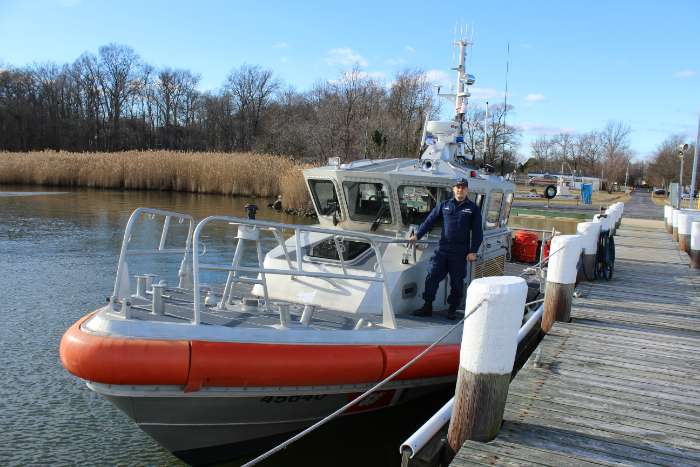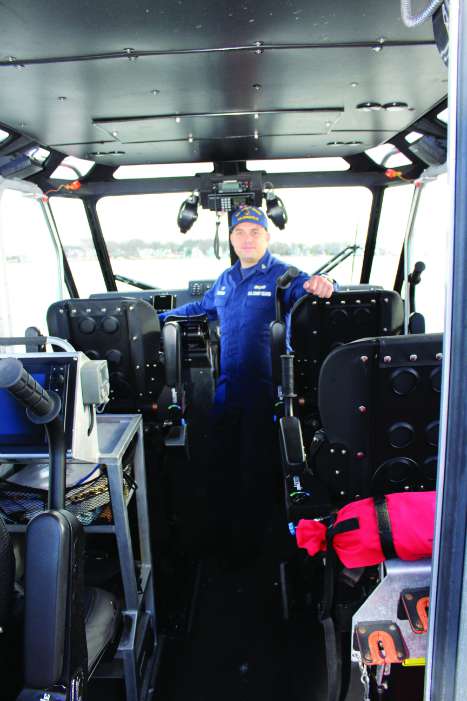How Coast Guard Station Annapolis Responds to Boaters
On a sunny but cold and breezy January afternoon I had the pleasure of meeting Senior Chief Matt Kinsman, officer in charge at the Coast Guard Station Annapolis. Senior chief Kinsman explained that although the Annapolis location is a ‘response’ station, its staff takes a ‘prevention’ stance to help promote boater safety, education, and good seamanship. Here are the answers to a few questions that I posed to him.

What happens when a call for help comes in?
When a distress call comes into the Annapolis station, immediately everyone gets very quiet and focuses on the situation being conveyed. I begin planning how best to respond: how to prep the boats, what equipment will be needed, how should we be dressed for the weather? Depending on the situation we may have a crew briefing at the station or on the rescue boat while “en route.” From the time a distress call comes in, our maximum allowable time to launch the boats is 30 minutes, but it usually doesn’t take that long. The average time is closer to 10 minutes.
Name a few things you would like sailors and boaters to know before leaving the dock.
In addition to the basics of operating their boat, it is important to understand weather, boat maintenance, safety procedures, crew management, and seamanship skills. Know your boat’s limits, but also know your own limits. We are here to help. I’d much rather someone call in with a question—whether it’s about the waterways, the weather, or to file a float plan—than to do a search and rescue. The Annapolis station can be reached at (410) 267-8107.
What are the top five things you want to know from a sailor or boater who makes a distress call?
Position: latitude and longitude are ideal, but we are familiar with buoys, daymarkers, and other landmarks.
Number of people onboard: it helps to know if there are children, or older persons, and whether the persons onboard can swim.
Lifejackets: How many people are wearing lifejackets?
Nature of the distress: tell us what’s wrong. For example, is your vessel disabled, do you have a medical concern, are you lost in inclement weather?
Description of the vessel: In addition to length, hull color, sail or power, we want to know information such as: is the bilge keeping up, has the hull been breached, does the boat have a tower, is part of the boat submerged, are there items floating in the water that would help make you easier to spot, such as a cooler or fenders? Have you set off a flare?

How many boats and staff are at the Annapolis station?
Annapolis station has 30 active staff and 15 reserve. We are always ready, 24/7, 365 days a year to respond to a call. Similar to a firehouse, a rescue crew is always on duty at the station. In addition to our command center, offices, and briefing rooms, we have a barracks for sleeping, a kitchen, space to relax, and a gym to workout.
Because the Annapolis station is situated near the state capitol, a major bridge, the US Naval Academy, and a body of water large enough that submarines sometimes visit, it has an elevated level of response capability compared to some other stations of its size.
Three boats are kept here, one 45-foot response boat-medium and two 29-foot response boats-small. We keep the bigger boat and one 29-footer in the water at all times. Bright orange inflatable life vests sit ready in each seat and are donned before the boats launch.
The rescue boats have many features, such as pumping devices capable of removing water from a vessel that is taking on water. The larger boat has joy sticks instead of a helm for excellent maneuverability. It also has a space designed specially to care for someone who has been rescued. In addition to climate control to warm-up or cool-off someone in distress, the space has blankets, potable water, and a microwave.
What is your area of responsibility?
Our area of responsibility (AOR) includes the Chester River, Eastern Bay, and Miles River on the Eastern Shore, and on the Western Shore, we are responsible for the Magothy, Severn, South, and West Rivers down to Chesapeake Beach. From Annapolis we can reach our northernmost AOR in about 20 minutes, and our southernmost AOR in about 30 minutes.
What is the best part of your job?
I really like community integration. We want to be partners in education and on the water. The Annapolis station welcomes school field trips and annually hosts an open house. We partner with the local fire and police, which have top-notch equipment and knowledgeable officers and staff. We are fortunate to have a saturation of first responders in this area, and we collaborate with them. The first on the scene might be a tow boat, a Maryland Department of Natural Resources waterborne rescue team, a fire department, or other responder.
What is your interface with the Coast Guard Auxiliary?
Our Auxiliary liaison at the Annapolis station keeps us informed about Auxiliary activities and where their boats are on patrol. On summer holidays or weekends, they might have three to five vessels on patrol. I dispatch our boats accordingly to cover as much area as possible. This makes them a real force multiplier. Most Auxiliarists have spent significant time on the water and are safety-minded, so they tend to have excellent seamanship skills.
~By Beth Crabtree
Safety Gear Onboard Boats
The US Coast Guard requires certain safety equipment to be onboard vessels of a certain size. These minimum equipment requirements are:
Lifejackets for each person onboard. For sailboats and powerboats 16 feet or longer, a throwable is also required.
Visual Distress Signals
Fire extinguishers
Ventilation
Backfire flame control
Sound producing device
Navigation lights




